Australian Pulse Bulletin
Wide row pulses and stubble retention
Key points
- Wider row and 'skip' row pulses (30 to 54 cm; 11" to 21") are working for southern pulse growers.
- Wide rows must be part of an overall system.
- Stubble retention, preferably standing stubble, is essential with wide rows.
- Key drivers are the combination of: (i) chasing yield and yield consistency (ii) better stubble clearance and other sowing practicalities (iii) improved water use efficiency (drought tolerance) (iv) minimise disease risk and easier management (v) desire to sow pulses early (vi) weed control through minimised soil disturbance.
Pulses fit well into a stubble retention system, and using wide rows can be part of that overall sowing system. In southern areas, depending on the initial standard spacing, this includes the use of wider tyne spacing or 'skip rows' that go out from 30 to 54 cm row spacing. Row spacing response may vary with the pulse species.
Growers are looking at wider rows in pulses (and oilseeds) for a range of different reasons, largely driven by combinations of chasing increased yield, consistency or stability of yield, disease control, fit in their system and general practicalities. Row spacing should however never be looked at in isolation, as it is only part of an overall system. Having stubble cover, preferably standing stubble, is an important component of a wider row system. For some growers the motivation to sow pulses in wider rows is to achieve better drought tolerance. Others are using it as a means to sow early, minimise disease risk and achieve better early pod set. Achieving better stubble flow during seeding, or better weed control through less soil disturbance, are also key drivers for many. This bulletin provides a SWOT analysis and some crop specific issues.
Strengths
Yield benefits, or increased consistency and stability through:
- Greater drought tolerance (lower rainfall areas) or less disease (higher rainfall)
- Less early moisture use, so moisture remains until needed during flowering and pod fill
- Less disease through delayed canopy closure
- Less use or delayed applications of fungicide
- Confidence to sow earlier than otherwise with reduced disease risk from delayed canopy closure.
- Better pollination in faba bean and broad bean
Practicalities are a key issue too:
- Greater sowing speed possible where soil throw is a speed limiter
- Less draft, hence reduced fuel use
- Better stubble clearance and flow
- Improved crop harvestability (crop height, speed, flow, trellising by standing stubble)
- Less weeds and reduced vigour through less soil disturbance
- Lower application rate/ha of granular or liquid inoculum might be possible, but only if the label specifies a rate per row
- A lower seeding rate may be possible, depending on what rate was previously used, but be sure plant population does not limit yield
- Less lodging at harvest (lentils particularly, if stubble standing)
- Use of IBS herbicides may be 'safer'
- Weeds more accessible with post-emergent herbicides
Weaknesses
- Less crop competition against weeds early
- Increased weed numbers is possible, particularly if the non-sowing tynes are not lifted
- Time taken to set up -to raise tynes, remove points, shift or block hoses
- Greater air speed required on air seeders to sow a higher volume per row.
- Potential inability to sow the volume of seed through the seed boot at standard or increased speed
- Potential for fertiliser toxicity if placed into a narrow seed row with the seed
- Loss of soil moisture early if no or inadequate stubble cover
- Cannot roll the pulse for harvestability without losing some erectness of standing stubble, hence some loss of trellising affect (but this is an issue at any spacing).
- Inability to throw soil far enough to effectively use IBS herbicides (e.g. trifluralin)
- If inadequate stubble or ground cover, the wide row crop may be more prone to aphids and hence viruses.
Threats
- Fear of not necessarily achieving maximum yields at low yielding, low biomass sites
- Fear of not achieving maximum yields at high yielding sites when disease is fully controlled
- Plant population may be the yield limitation, not row spacing
- BGM could multiply on stubble if it remains wet (but less lodging counteracts that too)
- Less crop competition early (delayed canopy closure)
- Inability to weed wipe lentils if standing stubble too tall for the crop
- Stems can be weaker in tall crops like beans if in a heavy stubble. If the crop is heavily shaded early, then later it can be more prone to lodging
- Snails can gather on standing stubble, even if they do not climb the pulse, e.g. chickpeas
- There is the possibility of more weeds if the whole system is not right, particularly if the soil is disturbed by a tyne that doesn’t sow.
Opportunities
- Inter-row sowing is made easier with wider rows
- Inter-row, shielded spraying is more possible
- Fungicide applications can be targeted onto crop plants only
- Wider row systems may influence variety choice
- Post-emergent herbicide application can be directed between crop rows with dropper nozzles inter-row
- Row spacing can be made to match yield potential (e.g. drought tolerance or when excess bulk is produced)
- Wider row systems assist in the move into disc seeders and a full zero-till system
-
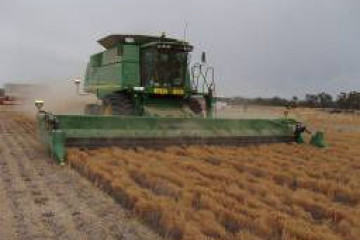
Wide row lentils held erect on standing stubble for harvest.
-
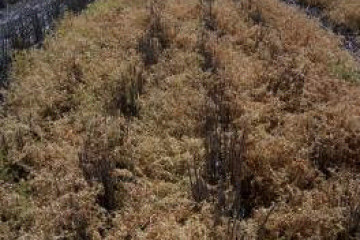
Lentils sown at 38 cm spacing trellising on standing stubble.
-
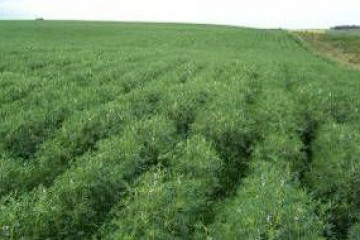
Wide row lupin in high rainfall area.
-
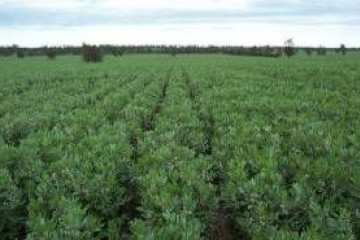
Fab bean sown on narrower rows (right, 37.5 cm) closed canopy before wide row faba bean (left, 75 cm rows).
-
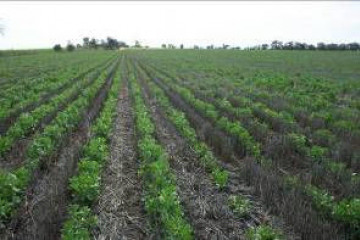
Wide row faba bean.
-
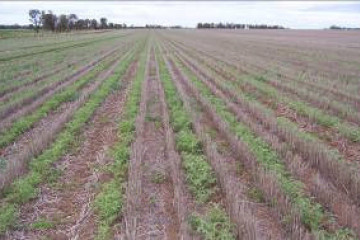
Wide row chickpea sown inter-row with standing cereal stubble.
-
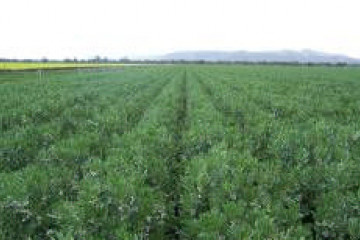
Faba beans in wide rows.
-
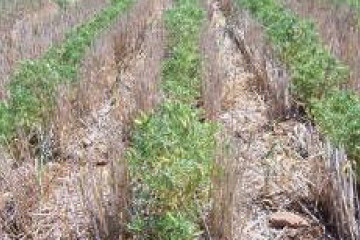
Lupins sown in wide rows for drought tolerance.
-
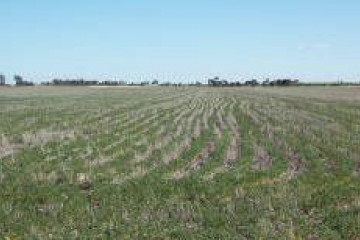
Wide row chickpea in standing stubble but not sown inter-row.
Lentil
- Confidence to sow earlier as canopy closure is delayed
- Erectness (trellising) if inter-row sown into standing stubble, even at 50 or 60 cm row spacing
- Greater crop and pod height
- Less lodging with trellising stubble, but greater lodging if no stubble support
- Canopy closure is delayed, so initial fungicide applied pre-canopy closure is later.
Chickpea
- Yield benefits have been obtained in drier areas
- Improved drought tolerance (through use of later moisture)
- Ease, speed and efficiency of harvest
- Shielded spraying becomes an option (e.g. ryegrass)
Faba/broad bean
- Confidence to sow earlier (disease, pod set)
- Delayed canopy closure so initial fungicide applied pre-canopy closure is later
- Better early pod set in lush growth conditions
- Easier access to pollinators (e.g. native bees)
- Less ‘plash’ diseases (cercospora, ascochyta) early when crop is sown into stubble
- Early erectness if inter-row into standing stubble, even at 50 or 60cm row spacing, but can lodge later if dense/tall stubble and crop
- Lowest pods are higher, hence more harvestable.
Lupin
- Better pod set in dense crop
- Confidence to sow earlier
- Taller crop with a longer flowering spike
- Inter-row spraying with shielded sprayers possible (e.g. WA for resistant weeds)
Field pea
- Wider rows are 'untested' commercially, but the aim would be to improve drought tolerance
- Do not prevent lodging, but crop stay more upright at harvest
- Crop can get 'straggly' with wide rows
- Black spot is less severe in standing peas versus flat peas
- Bacterial blight is not as severe in a standing stubble compared with in a flattened (mulched) stubble
Key contacts
Disclaimer
Information provided in this guide was correct at the time of the date shown below. No responsibility is accepted by Pulse Australia for any commercial outcomes from the use of information contained in this guide.
The information herein has been obtained from sources considered reliable but its accuracy and completeness cannot be guaranteed. No liability or responsibility is accepted for any errors or for any negligence, omissions in the contents, default or lack of care for any loss or damage whatsoever that may arise from actions based on any material contained in this publication.
Readers who act on this information do so at their own risk.
Copyright © 2015 Pulse Australia
All rights reserved. The information provided in the publication may not be reproduced in part or in full, in any form whatsoever, without the prior written consent of Pulse Australia.
Last updated: 20 November 2015
